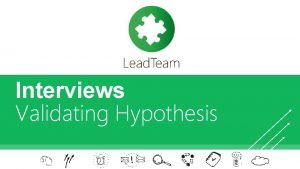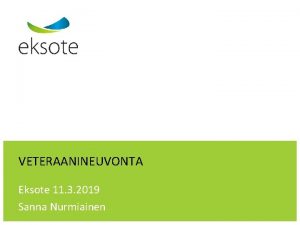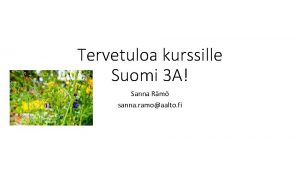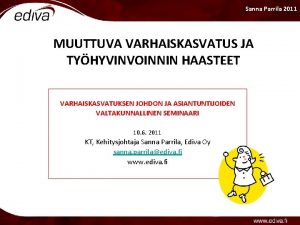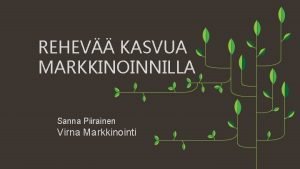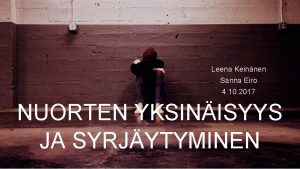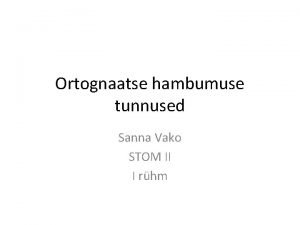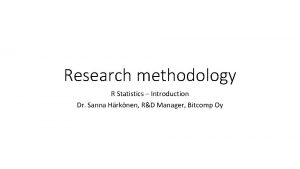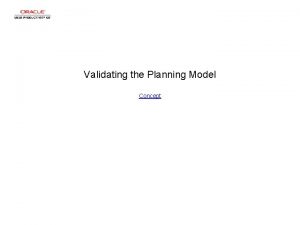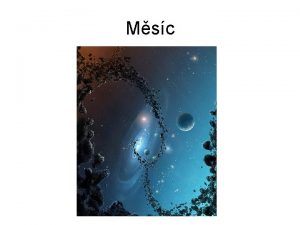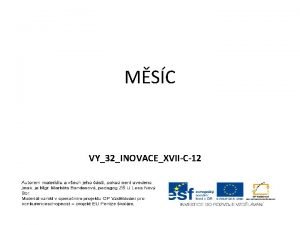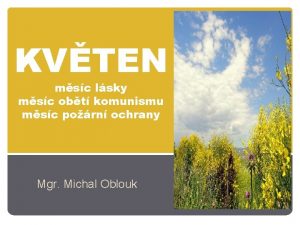Research methodology MSC COURSE VALIDATING of MODELS Sanna










- Slides: 10

Research methodology MSC COURSE VALIDATING of MODELS Sanna HÄRKÖNEN 1

LECTURE CONTENTS 1. Validating of models • Model BIAS and RMSE 2. Instructions for doing the course group work 2

VALIDATING MODELS • Important information about model’s applicability. Does it work also outside of modeling data set? • For example: leaf biomass model has been fitted with inventory data from Southern Finland. Can you apply the same model for Lappland? 3

Concept 1. Modeling data set: • Data set used for building a model • For example TREE_BIOMASS = f(height, diameter) • Checking model results: R 2, p-values, residuals • -> Goodness of the model in your modeling data set 2. Evaluation data set: • Another data set used for checking, if model works also elsewhere • Running the existing model with this data and comparing the model results with measured data 4

30 Example case R 2 = 0, 9628 25 20 • You have build a model, which estimates tree height as a function of tree diameter H= f(D). Modeling data was measured in Northern Finland. Height (m)15 10 5 • Does it work properly in other areas? -> check with data from elsewhere. For example: apply model to calculate H for trees with Joensuu data and compare the modeled and measured values. Do the results differ those in the modeling data set? Are the differences significant? 0 0 5 10 15 20 Diameter (cm) 25 30 40 35 30 25 20 Height (m) 15 10 5 0 -5 0 5 10 15 20 Diameter (cm) 25 30 5

Modeled VALIDATING MODELS • Commonly used measures: • RMSE (ROOT MEAN SQUARED ERROR) • Describes how much scatter there is between the measured and modeled values • Precision Measured Modeled • BIAS • Describes how much the average level of the modeled values differ from the measured ones • Accuracy Measured 6

Absolute RMSE and relative RMSE (%): Meas H Mod H SUM((meas. Hmod. H)^2) 4 4 0 13 16 9 16 19 9 2 3 1 3 4 1 0+9+9+1+1=20 7

ABSOLUTE BIAS and RELATIVE BIAS% Meas. H Mod SUM(meas. H-mod. H) H 4 4 0 13 16 -3 16 19 -3 2 3 -1 3 4 -1 0+(-3)+(-1)= -8 8

BIAS AND RMSE: what do they mean? BIAS = -1. 6 RMSE = 2. 0 MODEL 2: 30 BIAS = -1. 4 25 MODELED H (m) MODEL 1: RMSE = 4. 7 20 • MODEL 3: 15 • BIAS = -7. 6 • RMSE = 7. 9 10 5 0 0 5 10 15 20 MEASURED H (m) 25 30 Bias -> Describes model’s tendency to systematically either over or underestimate the values RMSE -> how much there is scatter between the modeled and measured values. With high RMSE, model can still be unbiased (i. e. it is averagely in the same level than the measured values) 9

BIAS AND RMSE: what do they mean? Significance of model bias? • Are the measured vs. modeled values statistically different, or is the bias just caused by random variation? • Can be tested by T-test by comparing the measured and modeled data sets together (see Blas’ lecture notes / T-test) • In R the command is: t. test(y 1, y 2, paired=TRUE) (y 1 and y 2 would be measured and modeled values in your data set, and paired=TRUE denotes that your two data sets includes data for same ”individuals”) • If T-test results (p-value) is <0. 05, the bias is significant 10
